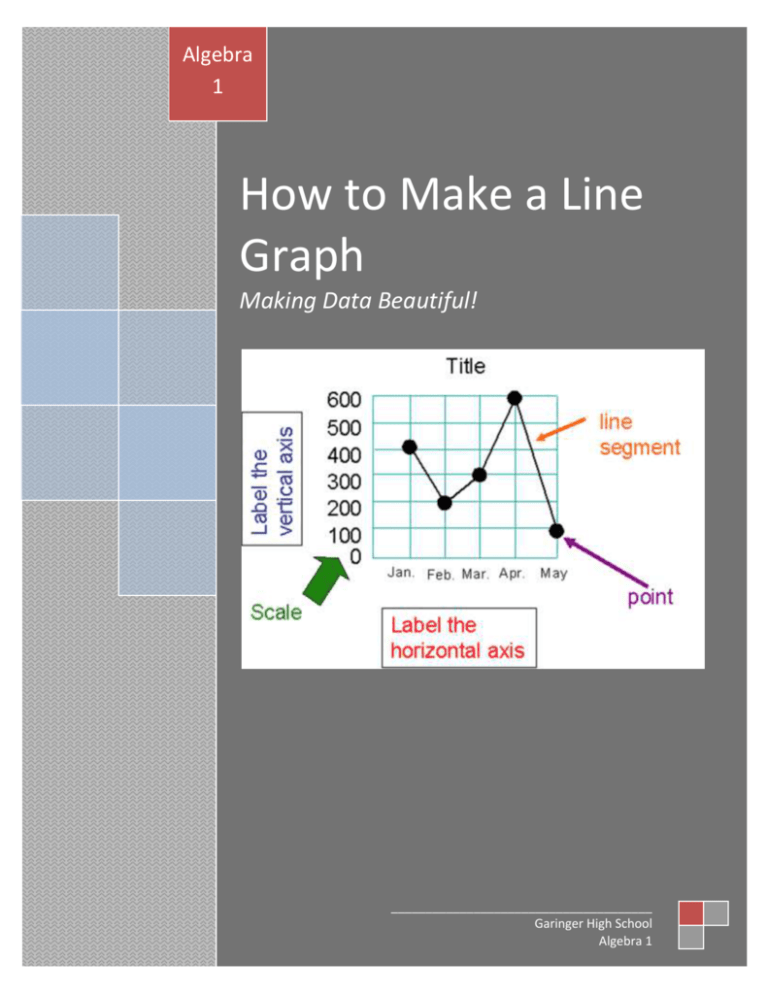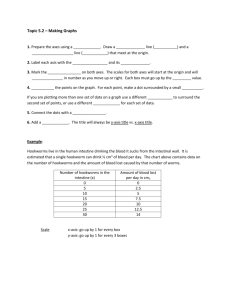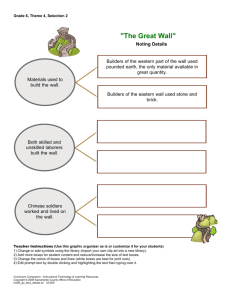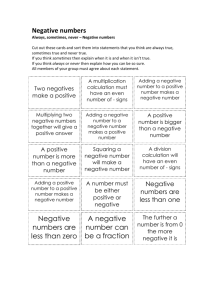Line Graph Book - CMS Secondary Math Wiki
advertisement

Algebra 1 How to Make a Line Graph Making Data Beautiful! ______________________________________ Garinger High School Algebra 1 Line Graph Activity A line graph is a way to visually show how two sets of data are related and how they vary depending on each other. Line graphs are particularly effective for showing change over time, predicting what comes next, or estimating what happened in between data points. How to Construct a Line Graph on Paper STEP WHAT TO DO HOW TO DO IT 1 Identify the a. Which of the variables do I control or vary? _____________. These values (the independent variables) would be ones that you measure or choose before conducting the experiment. b. The x-axis (horizontal) represents the independent variable. c. Which of the variables was affected as a result of the experiment? These variables (the dependent variables) would be the ones that you measure during the experiment that would correlate one-onone with the independent variable values. d. The y-axis (vertical) typically represents the dependent variable. 2 Determine a _____________ for each _____________. a. Goal: Fit the entire range of data over the available space. b. Find the range (lowest to highest values). If necessary, round down the lowest data value and round up the highest data value. Find the difference. c. Count the boxes on the axis that you want to use to represent the range. It is fine to round down. 𝑑𝑎𝑡𝑎 𝑟𝑎𝑛𝑔𝑒 d. Determine the scale: 𝑡𝑜𝑡𝑎𝑙 𝑛𝑢𝑚𝑏𝑒𝑟 𝑜𝑓 𝑏𝑜𝑥𝑒𝑠 3 Number and _____________ each axis. a. Mark the scale values on each axis. b. Label each axis with the type of data and unit. 4 Plot the _____ Plot each pair of data values on the graph with _____________. a dot (independent-dependent pair). 5 Draw the Draw a curve or line that best fits the data _____________. points. 6 If necessary, If you have multiple sets of dependent-variable include a data, use a color-coded key to name each set. _____________. 7 _____________ the graph. a. Your title should include both of the variables that are being compared. b. Someone should be able to read the title and know exactly what the graph shows. Line Graph Scaling Examples The data table shows the time and distance a car traveled on a road. Make a line graph of the data table. Time (Hr) 0 1 2 3 4 5 6 Distance 0 50 100 150 200 230 250 (Km) 1. The time variable is the _______________ variable. It’ll go on the _____-axis. The distance variable is the _______________ variable. It’ll go on the _____-axis. 2. What is the range of the time data? _____ to _____. The difference is ______. 3. Count the number of boxes on the x-axis: _______. 4. You have ______ boxes to represent ______ hours. Since you have more boxes than hours, you’ll need multiple boxes to represent each hour. How many boxes would represent 1 hour? Divide the number of boxes by the number of equal intervals: ____ ÷ _____ = _____. This means that _______ boxes represent 1 hour. 5. On the x-axis, starting at the left-most line and labeling that 0, count ___ boxes and then draw a tick mark and call it 1 hour. Continue counting ___ boxes, drawing tick marks, and labeling each tick mark. 6. What is the range of the distance data? _____ to ______. The difference is ______. Count the number of boxes on the y-axis: _____. 7. You have ____ boxes to represent _____ kilometers. Since you have fewer boxes than kilometers, each box needs to represent multiple kilometers. So how many kilometers would 1 box represent? Divide the number of kilometers by the number of boxes: ______ ÷ _____ = _________. This means that 1 box would represent ____________ kilometers. Let’s round up. 8. On the y-axis, starting at the bottom most line and labeling that 0, you can mark the next box (0 + 12 = 12 ) and continue marking each box 12 more than the previous one. You can also count in increments of 5 boxes and add 60 (12 × 5 = 40), or count in increments of 10 boxes and add 120 (12 × 10 = 120). What are the advantages of each kind of labeling? 9. Label your axes and give the graph a title. Exercise 1 The data table below shows the average value of a truck as the mileage on the truck increases. Answer the questions that follow and make a line graph to represent the data. Mileage (Kilometers) Truck’s Value (Dollars) 0 20,000 $14,000 $12,000 40,000 60,000 80,000 100,000 120,000 $8,000 $5,000 $4,000 $3,500 $3,000 1. What is the independent variable? How do you know? 2. What is the dependent variable? How do you know? 3. Write x next to the data table row that contains data values for the x-axis. 4. Write y next to the data table row that contains data values for the y-axis. 5. To scale the x-axis: a. Find the range of the data values: __________ to __________. The difference is: __________. b. Count the number of boxes along the x-axis: _________. 𝑑𝑎𝑡𝑎 𝑟𝑎𝑛𝑔𝑒 c. Determine the scale: = 𝑡𝑜𝑡𝑎𝑙 𝑛𝑢𝑚𝑏𝑒𝑟 𝑜𝑓 𝑏𝑜𝑥𝑒𝑠 d. Use the above information to label the scale values. e. Label the x-axis. 6. Repeat step 5 to scale the y-axis. Show your work below. 7. Plot the data on the graph. 8. Give the graph a title that best describes the data shown. Answer the questions below using the graph. 9. What was the value of the truck when the mileage was 100,000? 10. When does the value of the truck decrease the most? 11. About how much is the truck worth when the mileage is 50,000? 12. How much will the truck be worth at 140,000 kilometers? How do you know? Exercise 2 The data table below shows the average thickness of annual treering growth in two forests as the trees age. Assume that thicknesses of the tree rings were measured during the same years. A thin ring usually indicates lack of water, forest fires, or a major insect infestation. A thick ring indicates just the opposite. Make a graph of the data. Age of the tree Average thickness of Average thickness of (Years) the annual rings in the annual rings in forest A (cm) forest B (cm) 10 2.0 2.2 20 2.2 2.5 30 3.5 3.6 35 3.0 3.8 50 4.5 4.0 60 4.3 4.5 Answer the questions below using the graph. 1. What was the average thickness of annual rings of 20-year-old trees in Forest B? 2. How old were the trees in both forests when the average thicknesses of the annual rings were about the same? 3. What would be a reasonable prediction for the average thickness of annual rings of 70-year-old trees in Forest B? 4. Based on this data, what can you conclude about Forest A and Forest B ? How do you know? What is your evidence?





